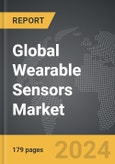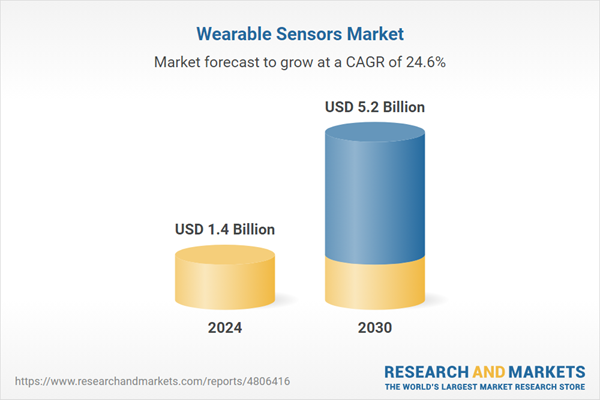Global Wearable Sensors Market - Key Trends & Drivers Summarized
Why Are Wearable Sensors Becoming Indispensable in Health and Fitness Monitoring?
Wearable sensors have become an essential component of health and fitness monitoring, enabling real-time tracking of various physiological and environmental parameters. These sensors, integrated into smartwatches, fitness bands, and medical devices, measure heart rate, body temperature, blood oxygen levels, glucose, and motion, providing valuable data for personal health management and clinical diagnostics. The increasing consumer interest in maintaining a healthy lifestyle, coupled with the growing adoption of wearable technology in healthcare, sports, and wellness sectors, is driving the demand for advanced wearable sensors. The ability to provide continuous and non-invasive monitoring makes wearable sensors indispensable for applications such as chronic disease management, elderly care, and sports performance optimization.How Are Technological Advancements Enhancing the Capabilities of Wearable Sensors?
Technological advancements in microelectronics, nanotechnology, and materials science are significantly enhancing the capabilities of wearable sensors. Innovations such as flexible and stretchable sensors, miniaturized electronics, and energy-efficient designs are enabling the development of lightweight, comfortable, and highly accurate sensors that can be integrated into a wide range of wearable devices. The use of advanced materials, such as graphene, organic polymers, and conductive textiles, is allowing for more precise and reliable sensing of biochemical and biomechanical signals. Additionally, the integration of AI and machine learning algorithms with wearable sensors is enabling more sophisticated data analysis, providing personalized insights and predictive analytics for health and fitness management. These advancements are expanding the application scope of wearable sensors beyond traditional health monitoring, including applications in augmented reality (AR), virtual reality (VR), and remote diagnostics.What Are the Challenges and Opportunities in the Wearable Sensors Market?
The wearable sensors market faces several challenges, including issues related to sensor accuracy, data privacy, battery life, and the integration of multiple sensors into a single device. Additionally, the market is highly fragmented, with numerous companies developing sensors for specific applications, leading to a lack of standardization and interoperability. However, these challenges also present opportunities for innovation and growth. The development of multi-functional, interoperable, and energy-efficient sensors that offer accurate and reliable data collection can help manufacturers gain a competitive edge. The increasing demand for wearable sensors in remote patient monitoring, sports analytics, and occupational safety is creating new growth opportunities. Moreover, the rising focus on personalized medicine and preventive healthcare is driving the need for advanced sensors that can provide continuous and real-time monitoring of various health parameters.What Is Driving the Growth of the Wearable Sensors Market?
The growth in the Wearable Sensors market is driven by several factors, including the rising demand for health and fitness monitoring, increasing adoption of wearable devices in healthcare and sports, and technological advancements in sensor design and data analytics. The growing focus on preventive healthcare and remote patient monitoring is significantly boosting the demand for wearable sensors that provide continuous and non-invasive monitoring of physiological parameters. Technological innovations in flexible and stretchable sensors, AI-driven data analysis, and energy-efficient designs are enhancing the properties and expanding the application scope of wearable sensors, making them more attractive to a wide range of end-users. The integration of wearable sensors in AR, VR, and IoT ecosystems is also driving market growth, as these technologies require real-time data for enhanced user experiences and decision-making. Additionally, the increasing emphasis on personalized and precision medicine is further fueling the demand for advanced wearable sensors.Report Scope
The report analyzes the Wearable Sensors market, presented in terms of units. The analysis covers the key segments and geographic regions outlined below.Segments: Type (Accelerometers, Magnetometers, Gyroscopes, Image Sensors, Inertial Sensors, Other Types).
Geographic Regions/Countries: World; United States; Canada; Japan; China; Europe (France; Germany; Italy; United Kingdom; Spain; Russia; and Rest of Europe); Asia-Pacific (Australia; India; South Korea; and Rest of Asia-Pacific); Latin America (Argentina; Brazil; Mexico; and Rest of Latin America); Middle East (Iran; Israel; Saudi Arabia; United Arab Emirates; and Rest of Middle East); and Africa.
Key Insights:
- Market Growth: Understand the significant growth trajectory of the Accelerometers segment, which is expected to reach US$1.8 Billion by 2030 with a CAGR of a 26.1%. The Magnetometers segment is also set to grow at 19.3% CAGR over the analysis period.
- Regional Analysis: Gain insights into the U.S. market, valued at $345.9 Million in 2024, and China, forecasted to grow at an impressive 31.1% CAGR to reach $1.5 Billion by 2030. Discover growth trends in other key regions, including Japan, Canada, Germany, and the Asia-Pacific.
Why You Should Buy This Report:
- Detailed Market Analysis: Access a thorough analysis of the Global Wearable Sensors Market, covering all major geographic regions and market segments.
- Competitive Insights: Get an overview of the competitive landscape, including the market presence of major players across different geographies.
- Future Trends and Drivers: Understand the key trends and drivers shaping the future of the Global Wearable Sensors Market.
- Actionable Insights: Benefit from actionable insights that can help you identify new revenue opportunities and make strategic business decisions.
Key Questions Answered:
- How is the Global Wearable Sensors Market expected to evolve by 2030?
- What are the main drivers and restraints affecting the market?
- Which market segments will grow the most over the forecast period?
- How will market shares for different regions and segments change by 2030?
- Who are the leading players in the market, and what are their prospects?
Report Features:
- Comprehensive Market Data: Independent analysis of annual sales and market forecasts in US$ Million from 2024 to 2030.
- In-Depth Regional Analysis: Detailed insights into key markets, including the U.S., China, Japan, Canada, Europe, Asia-Pacific, Latin America, Middle East, and Africa.
- Company Profiles: Coverage of players such as Analog Devices, Inc., APDM Inc., Asahi Kasei Microdevices Corporation, Bartington Instruments Ltd., Breathevision and more.
- Complimentary Updates: Receive free report updates for one year to keep you informed of the latest market developments.
Some of the 12 companies featured in this Wearable Sensors market report include:
- Analog Devices, Inc.
- APDM Inc.
- Asahi Kasei Microdevices Corporation
- Bartington Instruments Ltd.
- Breathevision
- Cosinuss GmbH
- DyCare
- Gait Up
- Hunter Apparel Solutions Ltd.
- I-Motion (Jiangsu Changwei Electronics. Inc)
Tariff Impact Analysis: Key Insights for 2025
Global tariff negotiations across 180+ countries are reshaping supply chains, costs, and competitiveness. This report reflects the latest developments as of April 2025 and incorporates forward-looking insights into the market outlook.The analysts continuously track trade developments worldwide, drawing insights from leading global economists and over 200 industry and policy institutions, including think tanks, trade organizations, and national economic advisory bodies. This intelligence is integrated into forecasting models to provide timely, data-driven analysis of emerging risks and opportunities.
What’s Included in This Edition:
- Tariff-adjusted market forecasts by region and segment
- Analysis of cost and supply chain implications by sourcing and trade exposure
- Strategic insights into geographic shifts
Buyers receive a free July 2025 update with:
- Finalized tariff impacts and new trade agreement effects
- Updated projections reflecting global sourcing and cost shifts
- Expanded country-specific coverage across the industry
Table of Contents
Companies Mentioned (Partial List)
A selection of companies mentioned in this report includes, but is not limited to:
- Analog Devices, Inc.
- APDM Inc.
- Asahi Kasei Microdevices Corporation
- Bartington Instruments Ltd.
- Breathevision
- Cosinuss GmbH
- DyCare
- Gait Up
- Hunter Apparel Solutions Ltd.
- I-Motion (Jiangsu Changwei Electronics. Inc)
Table Information
| Report Attribute | Details |
|---|---|
| No. of Pages | 179 |
| Published | April 2025 |
| Forecast Period | 2024 - 2030 |
| Estimated Market Value ( USD | $ 1.4 Billion |
| Forecasted Market Value ( USD | $ 5.2 Billion |
| Compound Annual Growth Rate | 24.6% |
| Regions Covered | Global |









